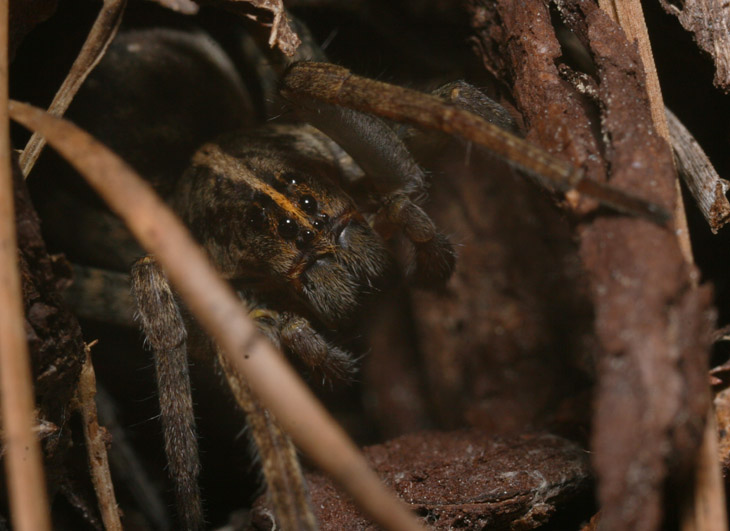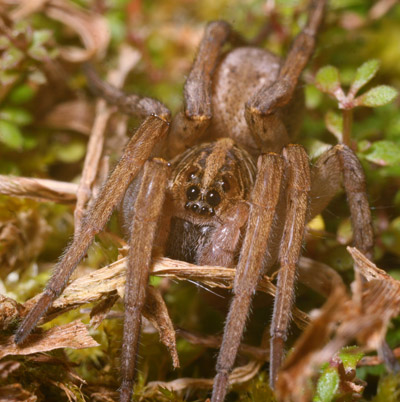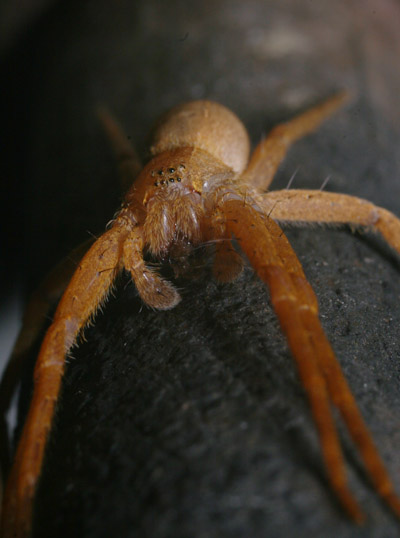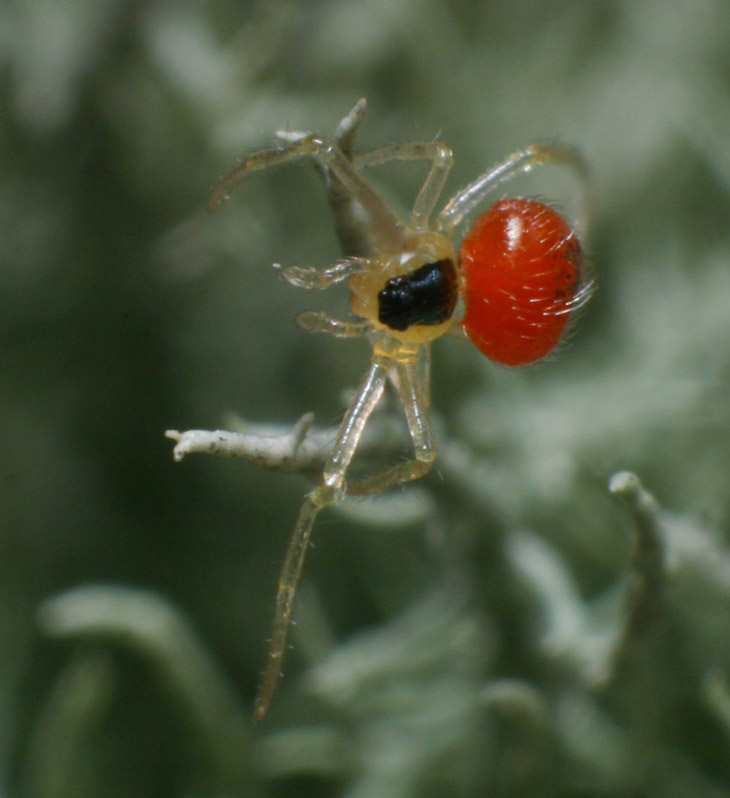
Back on the evening of March 1st, the weather was remarkably warm, and walking around with a bright flashlight held near my eyes revealed numerous arachnids taking immediate advantage of the conditions. Well, to some extent, anyway – there wasn’t much activity to be seen, just their presence, wallflowers at the spring dance; leave it to me to come up with ridiculously inappropriate phrasing. The easiest to spot with the flashlight technique are the wolf spiders of course, which live in burrows, and nearly all of those that I found were remaining on their ‘front porch,’ ducking inside at the slightest sign of danger like the nosy neighbor in a sixties sitcom.
 There are too many species of wolf spider to identify any individual in situ, especially when it might require examining the stripes on the underside, so these will simply be classed in the family Lycosidae. The one seen here was caught too far from its protective burrow, so it simply hunkered down with its legs drawn close for protection when I loomed in for the portrait. As nasty as they might appear, they’re quite shy, but notably I only got these images because these two, both appearing to be males, were less wary than the large female I approached numerous times, one who retreated into her burrow before I could ever get her in the viewfinder. The gender might actually have something to do with this, the males having to weigh discretion against not actually finding a female to mate with. Much as we might like it to be otherwise, there are very few species where the males can just wait for the females to come calling…
There are too many species of wolf spider to identify any individual in situ, especially when it might require examining the stripes on the underside, so these will simply be classed in the family Lycosidae. The one seen here was caught too far from its protective burrow, so it simply hunkered down with its legs drawn close for protection when I loomed in for the portrait. As nasty as they might appear, they’re quite shy, but notably I only got these images because these two, both appearing to be males, were less wary than the large female I approached numerous times, one who retreated into her burrow before I could ever get her in the viewfinder. The gender might actually have something to do with this, the males having to weigh discretion against not actually finding a female to mate with. Much as we might like it to be otherwise, there are very few species where the males can just wait for the females to come calling…
 This one I spotted initially when I didn’t have the camera in hand, perched on the pole supporting a bird feeder. After chasing the wolf spiders, I came back past to find it still in the same position, reluctant to move even as I positioned myself underneath for the portrait. The reason for this can just barely be made out if you look close, since it had already captured a meal and was lethargically gnawing through it. This is another male – the ‘boxing glove‘ ends of the pedipalps, those little leglike appendages, are a giveaway. I found this slightly curious in that, by far, what I see most are females, but maybe I just haven’t been watching enough early in the season to see the males in their active times. This one I’m going to tentatively identify as a nursery web spider (Pisaurina mira,) but I stand to be corrected on that – there are several species with a similar appearance. Nursery web spiders, unsurprisingly, feed on stray packets of information found on the internet network for arborists and orchard staff; nursery web, get it?
This one I spotted initially when I didn’t have the camera in hand, perched on the pole supporting a bird feeder. After chasing the wolf spiders, I came back past to find it still in the same position, reluctant to move even as I positioned myself underneath for the portrait. The reason for this can just barely be made out if you look close, since it had already captured a meal and was lethargically gnawing through it. This is another male – the ‘boxing glove‘ ends of the pedipalps, those little leglike appendages, are a giveaway. I found this slightly curious in that, by far, what I see most are females, but maybe I just haven’t been watching enough early in the season to see the males in their active times. This one I’m going to tentatively identify as a nursery web spider (Pisaurina mira,) but I stand to be corrected on that – there are several species with a similar appearance. Nursery web spiders, unsurprisingly, feed on stray packets of information found on the internet network for arborists and orchard staff; nursery web, get it?
Let’s just pretend I never said that…
The final arachnid for this post (but certainly not for the year, rest assured, or agitated, whatever) is one that I haven’t even come close to identifying, perhaps because it’s a juvenile and thus not in adult coloration. It’s tiny, which is understating the case; it measures no more than a millimeter in body length. The backdrop is lichen, the fuzzy stuff that is found in small patches on tree trunks sometimes.

I tried to shoot it perched on a fingertip for a better scale shot, but it clearly did not approve of this surface and hyperactively scrambled around trying to get off, preventing me from even catching it in the viewfinder, much less in focus; the lichen at least caused it to clamber across the tendrils and slowed it down a little. The best way to start identifying spider species, the eye pattern, is next to indistinguishable against the black carapace. From body shape and what little I can see about the eyes, I’m only going to guess that it’s a juvenile orb weaver. I would also guess that the coloration is aposematic, the bright and contrasted ‘keepaway’ signal indicating that it’s toxic or otherwise unpalatable – being bright red doesn’t seem to be the best of traits when one is that small, but there remains the possibility that whatever is likely to prey on it cannot see the same hues. If it’s not obvious, I’m just spitballing here, so chime in and correct my ignorance if you like; you have the advantage that, if you sound like you know what you’re talking about, you can completely bullshit me and I’ll buy it anyway, unable to correct you from my own ignorance.
Spring is coming, and with it I expect to be posting more and, wonder of wonders, maybe something other than spiders. Bear with me (I know it’s hard.)




















































